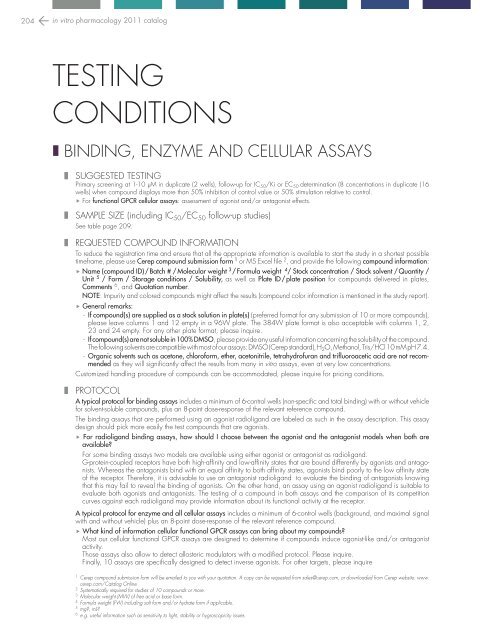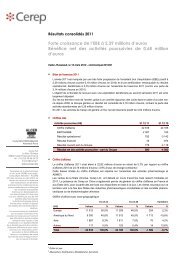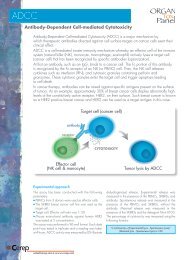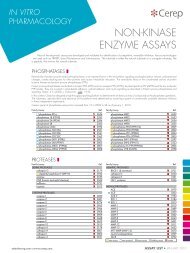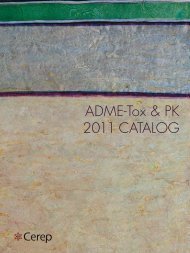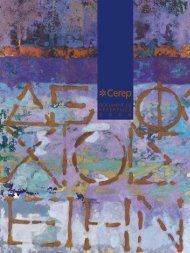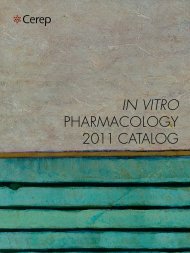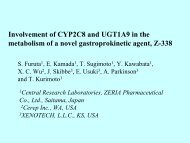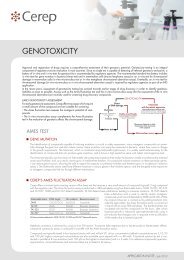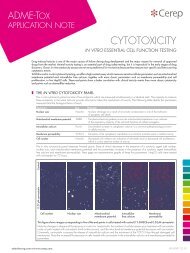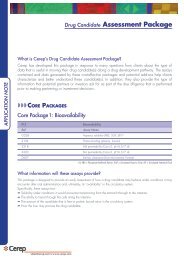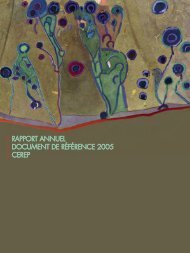in vitro PHARMACOLOGY 2011 CATALOG - Cerep
in vitro PHARMACOLOGY 2011 CATALOG - Cerep
in vitro PHARMACOLOGY 2011 CATALOG - Cerep
Create successful ePaper yourself
Turn your PDF publications into a flip-book with our unique Google optimized e-Paper software.
204 <strong>in</strong> <strong>vitro</strong> pharmacology <strong>2011</strong> catalog<br />
test<strong>in</strong>g<br />
conditions<br />
❚ b<strong>in</strong>d<strong>in</strong>g, enzyme and cellular assays<br />
❚ suggested test<strong>in</strong>g<br />
Primary screen<strong>in</strong>g at 1-10 µM <strong>in</strong> duplicate (2 wells), follow-up for IC 50 /Ki or EC 50 determ<strong>in</strong>ation (8 concentrations <strong>in</strong> duplicate (16<br />
wells) when compound displays more than 50% <strong>in</strong>hibition of control value or 50% stimulation relative to control.<br />
For functional GPCR cellular assays: assessment of agonist and/or antagonist effects.<br />
❚ sample size (<strong>in</strong>clud<strong>in</strong>g IC 50 /EC 50 follow-up studies)<br />
See table page 209.<br />
❚ requested compound <strong>in</strong>formation<br />
To reduce the registration time and ensure that all the appropriate <strong>in</strong>formation is available to start the study <strong>in</strong> a shortest possible<br />
timeframe, please use <strong>Cerep</strong> compound submission form 1 or MS Excel file 2 , and provide the follow<strong>in</strong>g compound <strong>in</strong>formation:<br />
Name (compound ID) / Batch # / Molecular weight 3 / Formula weight 4 / Stock concentration / Stock solvent / Quantity /<br />
Unit 5 / Form / Storage conditions / Solubility, as well as Plate ID / plate position for compounds delivered <strong>in</strong> plates,<br />
Comments 6 , and Quotation number.<br />
NOTE: Impurity and colored compounds might affect the results (compound color <strong>in</strong>formation is mentioned <strong>in</strong> the study report).<br />
General remarks:<br />
- If compound(s) are supplied as a stock solution <strong>in</strong> plate(s) (preferred format for any submission of 10 or more compounds),<br />
please leave columns 1 and 12 empty <strong>in</strong> a 96W plate. The 384W plate format is also acceptable with columns 1, 2,<br />
23 and 24 empty. For any other plate format, please <strong>in</strong>quire.<br />
- If compound(s) are not soluble <strong>in</strong> 100% DMSO, please provide any useful <strong>in</strong>formation concern<strong>in</strong>g the solubility of the compound.<br />
The follow<strong>in</strong>g solvents are compatible with most of our assays: DMSO (<strong>Cerep</strong> standard), H 2 O, Methanol, Tris/HCl 10 mM pH 7.4.<br />
- Organic solvents such as acetone, chloroform, ether, acetonitrile, tetrahydrofuran and trifluoroacetic acid are not recommended<br />
as they will significantly affect the results from many <strong>in</strong> <strong>vitro</strong> assays, even at very low concentrations.<br />
Customized handl<strong>in</strong>g procedure of compounds can be accommodated, please <strong>in</strong>quire for pric<strong>in</strong>g conditions.<br />
❚ protocol<br />
A typical protocol for b<strong>in</strong>d<strong>in</strong>g assays <strong>in</strong>cludes a m<strong>in</strong>imum of 6-control wells (non-specific and total b<strong>in</strong>d<strong>in</strong>g) with or without vehicle<br />
for solvent-soluble compounds, plus an 8-po<strong>in</strong>t dose-response of the relevant reference compound.<br />
The b<strong>in</strong>d<strong>in</strong>g assays that are performed us<strong>in</strong>g an agonist radioligand are labeled as such <strong>in</strong> the assay description. This assay<br />
design should pick more easily the test compounds that are agonists.<br />
For radioligand b<strong>in</strong>d<strong>in</strong>g assays, how should I choose between the agonist and the antagonist models when both are<br />
available?<br />
For some b<strong>in</strong>d<strong>in</strong>g assays two models are available us<strong>in</strong>g either agonist or antagonist as radioligand.<br />
G-prote<strong>in</strong>-coupled receptors have both high-aff<strong>in</strong>ity and low-aff<strong>in</strong>ity states that are bound differently by agonists and antagonists.<br />
Whereas the antagonists b<strong>in</strong>d with an equal aff<strong>in</strong>ity to both aff<strong>in</strong>ity states, agonists b<strong>in</strong>d poorly to the low aff<strong>in</strong>ity state<br />
of the receptor. Therefore, it is advisable to use an antagonist radioligand to evaluate the b<strong>in</strong>d<strong>in</strong>g of antagonists know<strong>in</strong>g<br />
that this may fail to reveal the b<strong>in</strong>d<strong>in</strong>g of agonists. On the other hand, an assay us<strong>in</strong>g an agonist radioligand is suitable to<br />
evaluate both agonists and antagonists. The test<strong>in</strong>g of a compound <strong>in</strong> both assays and the comparison of its competition<br />
curves aga<strong>in</strong>st each radioligand may provide <strong>in</strong>formation about its functional activity at the receptor.<br />
A typical protocol for enzyme and all cellular assays <strong>in</strong>cludes a m<strong>in</strong>imum of 6-control wells (background, and maximal signal<br />
with and without vehicle) plus an 8-po<strong>in</strong>t dose-response of the relevant reference compound.<br />
What k<strong>in</strong>d of <strong>in</strong>formation cellular functional GPCR assays can br<strong>in</strong>g about my compounds?<br />
Most our cellular functional GPCR assays are designed to determ<strong>in</strong>e if compounds <strong>in</strong>duce agonist-like and/or antagonist<br />
activity.<br />
Those assays also allow to detect allosteric modulators with a modified protocol. Please <strong>in</strong>quire.<br />
F<strong>in</strong>ally, 10 assays are specifically designed to detect <strong>in</strong>verse agonists. For other targets, please <strong>in</strong>quire<br />
1 <strong>Cerep</strong> compound submission form will be emailed to you with your quotation. A copy can be requested from sales@cerep.com, or downloaded from <strong>Cerep</strong> website: www.<br />
cerep.com/Catalog Onl<strong>in</strong>e<br />
2 Systematically required for studies of 10 compounds or more.<br />
3 Molecular weight (MW) of free acid or base form.<br />
4 Formula weight (FW) <strong>in</strong>clud<strong>in</strong>g salt form and/or hydrate form if applicable.<br />
5 mg?, mL?<br />
6 e.g. useful <strong>in</strong>formation such as sensitivity to light, stability or hygroscopicity issues.


